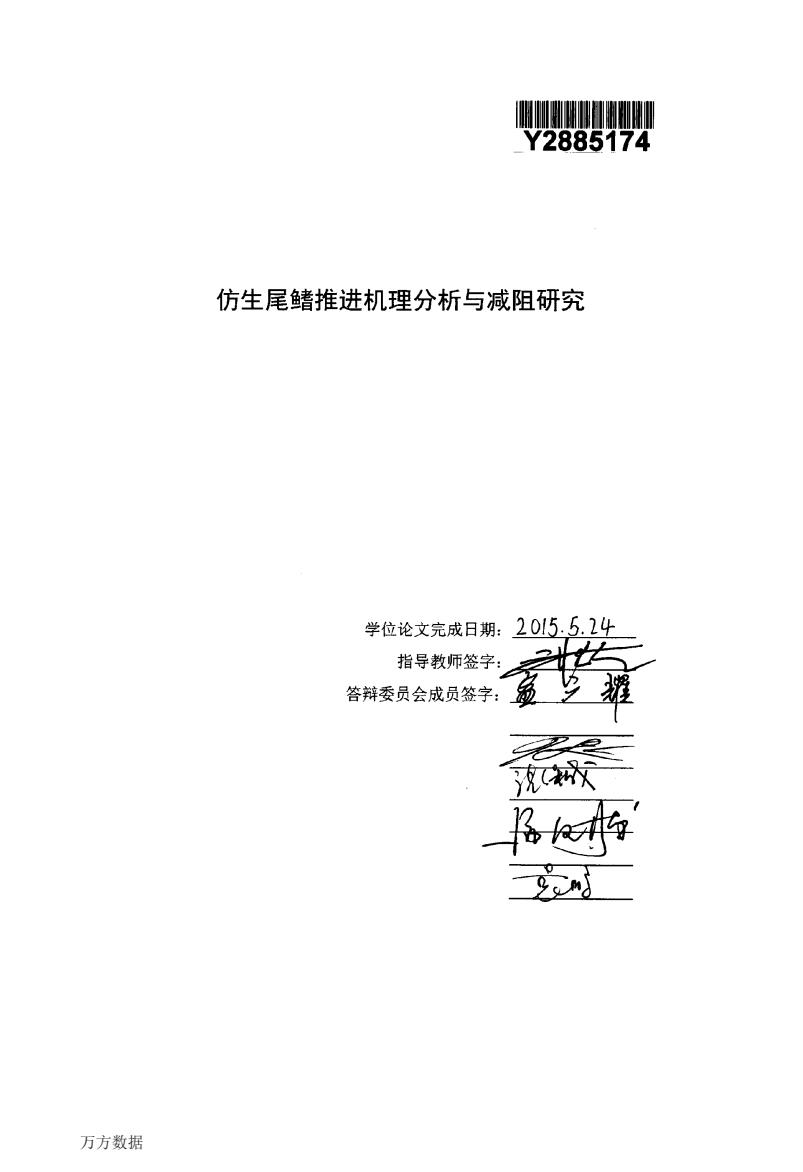
Y2885174 仿生尾鳍推进机理分析与减阻研究 学位论文完成日期:2015.5.24 指导教师签字: 答辩委员会成员签字: 万方数据
lIII I Ill II III I H II III Y28851 74 仿生尾鳍推进机理分析与减阻研究 学位论文完成日期 指导教师签字 答辩委员会成员签字 蒸一 万方数据
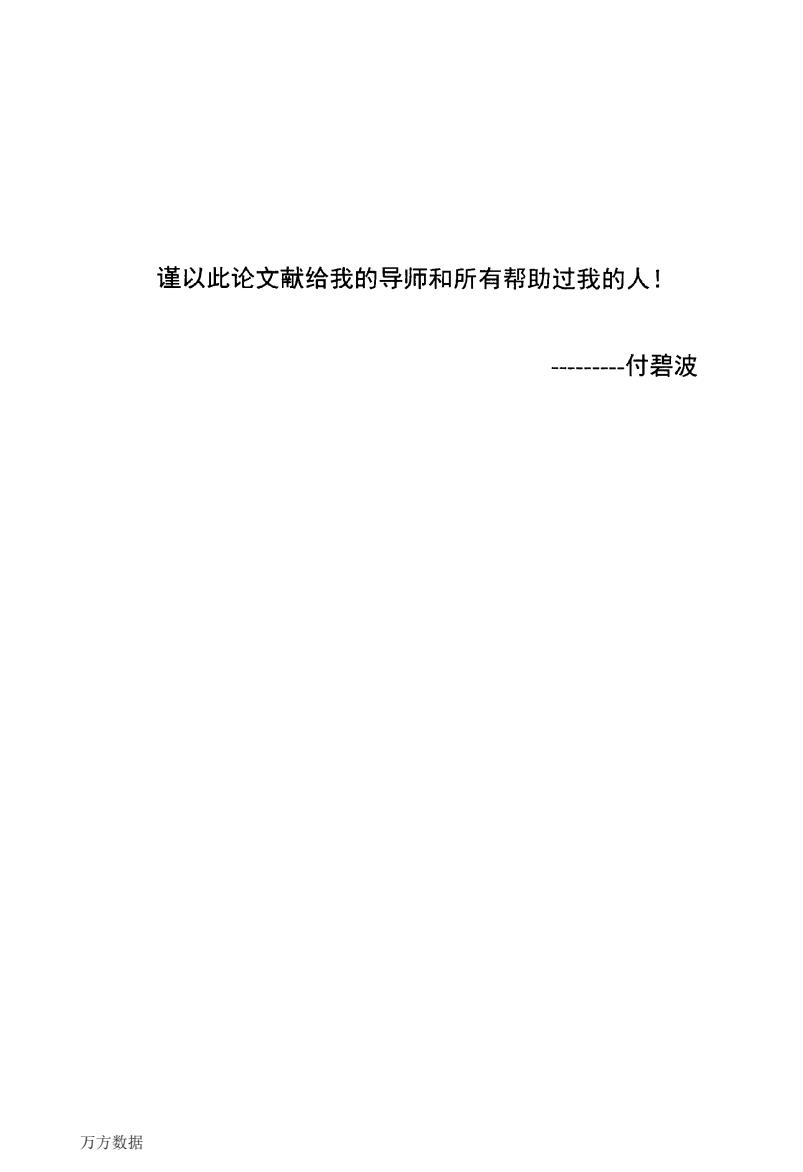
谨以此论文献给我的导师和所有帮助过我的人! ---付碧波 万方数据
谨以此论文献给我的导师和所有帮助过我的人! ………付碧波 万方数据
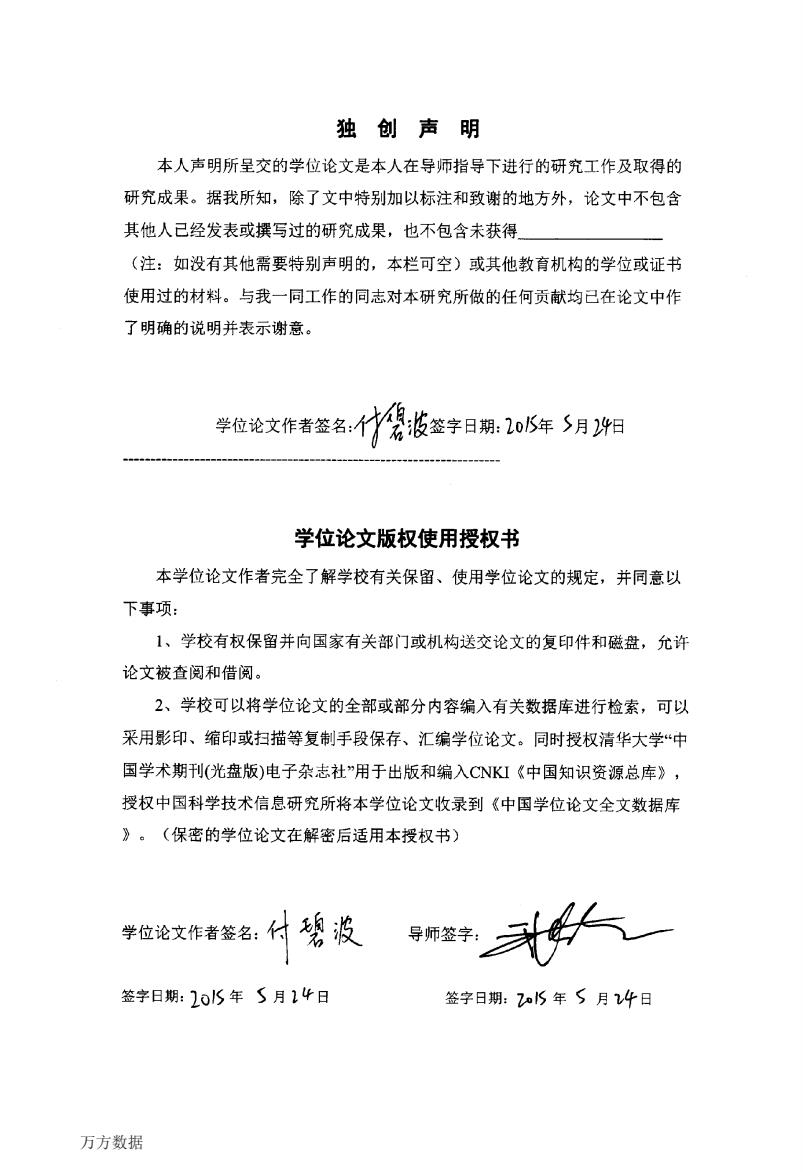
独创声明 本人声明所呈交的学位论文是本人在导师指导下进行的研究工作及取得的 研究成果。据我所知,除了文中特别加以标注和致谢的地方外,论文中不包含 其他人已经发表或撰写过的研究成果,也不包含未获得 (注:如没有其他需要特别声明的,本栏可空)或其他教育机构的学位或证书 使用过的材料。与我一同工作的同志对本研究所做的任何贡献均已在论文中作 了明确的说明并表示谢意。 学位论文作者签名: 竹2版签字日期:10S年5月阳 学位论文版权使用授权书 本学位论文作者完全了解学校有关保留、使用学位论文的规定,并同意以 下事项: 1、学校有权保留并向国家有关部门或机构送交论文的复印件和磁盘,允许 论文被查阅和借阅。 2、学校可以将学位论文的全部或部分内容编入有关数据库进行检索,可以 采用影印、缩印或扫描等复制手段保存、汇编学位论文。同时授权清华大学“中 国学术期刊(光盘版)电子杂志社”用于出版和编入CNKI《中国知识资源总库》, 授权中国科学技术信息研究所将本学位论文收录到《中国学位论文全文数据库 》。(保密的学位论文在解密后适用本授权书) 学位论文作者签名: 导师签字: 签字日期:2o15年S月14日 签字日期:ZS年S月4日 万方数据
独创声明 本人声明所呈交的学位论文是本人在导师指导下进行的研究工作及取得的 研究成果。据我所知,除了文中特别加以标注和致谢的地方外,论文中不包含 其他人已经发表或撰写过的研究成果,也不包含未获得—— (注:如没有其他需要特别声明的,本栏可空)或其他教育机构的学位或证书 使用过的材料。与我一同工作的同志对本研究所做的任何贡献均已在论文中作 了明确的说明并表示谢意。 学位论文作者虢懈;笈签字隰郦年多月辨日 学位论文版权使用授权书 本学位论文作者完全了解学校有关保留、使用学位论文的规定,并同意以 下事项: 1、学校有权保留并向国家有关部门或机构送交论文的复印件和磁盘,允许 论文被查阅和借阅。 2、学校可以将学位论文的全部或部分内容编入有关数据库进行检索,可以 采用影印、缩印或扫描等复制手段保存、汇编学位论文。同时授权清华大学“中 国学术期刊(光盘版)电子杂志社”用于出版和编入CNKI《中国知识资源总库》, 授权中国科学技术信息研究所将本学位论文收录到《中国学位论文全文数据库 》。 (保密的学位论文在解密后适用本授权书) 学位论文作者签名:q确;良 签字日期:10f5年S月l妒日 导师签字: 签字日期:加f5年S月1,午日 万方数据
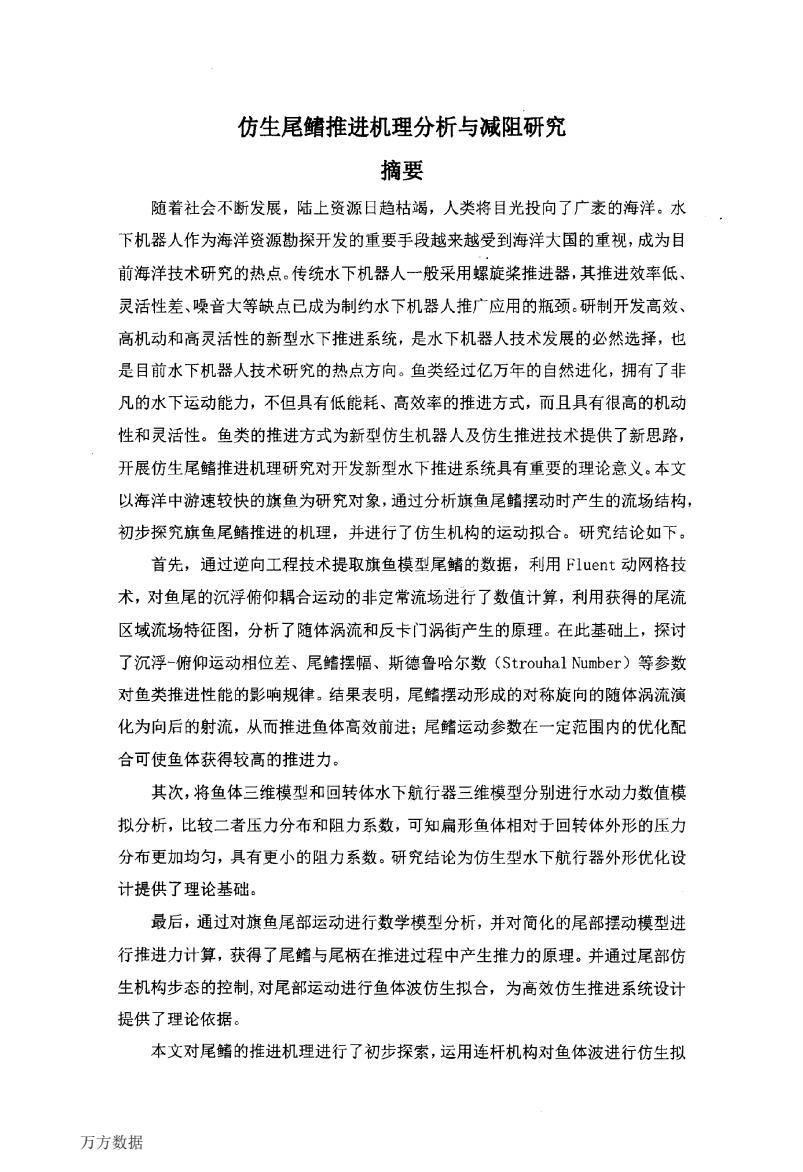
仿生尾鳍推进机理分析与减阻研究 摘要 随着社会不断发展,陆上资源日趋枯竭,人类将目光投向了广表的海洋。水 下机器人作为海洋资源勘探开发的重要手段越来越受到海洋大国的重视,成为目 前海洋技术研究的热点。传统水下机器人一般采用螺旋桨推进器,其推进效率低、 灵活性差、噪音大等缺点己成为制约水下机器人推广应用的瓶颈。研制开发高效、 高机动和高灵活性的新型水下推进系统,是水下机器人技术发展的必然选择,也 是目前水下机器人技术研究的热点方向。鱼类经过亿万年的自然进化,拥有了非 凡的水下运动能力,不但具有低能耗、高效率的推进方式,而且具有很高的机动 性和灵活性。鱼类的推进方式为新型仿生机器人及仿生推进技术提供了新思路, 开展仿生尾鳍推进机理研究对开发新型水下推进系统具有重要的理论意义。本文 以海洋中游速较快的旗鱼为研究对象,通过分析旗鱼尾鳍摆动时产生的流场结构, 初步探究旗鱼尾鳍推进的机理,并进行了仿生机构的运动拟合。研究结论如下。 首先,通过逆向工程技术提取旗鱼模型尾鳍的数据,利用Fluent动网格技 术,对鱼尾的沉浮俯仰耦合运动的非定常流场进行了数值计算,利用获得的尾流 区域流场特征图,分析了随体涡流和反卡门涡街产生的原理。在此基础上,探讨 了沉浮-俯仰运动相位差、尾鳍摆幅、斯德鲁哈尔数(Strouhal Number)等参数 对鱼类推进性能的影响规律。结果表明,尾鳍摆动形成的对称旋向的随体涡流演 化为向后的射流,从而推进鱼体高效前进:尾鳍运动参数在一定范围内的优化配 合可使鱼体获得较高的推进力。 其次,将鱼体三维模型和回转体水下航行器三维模型分别进行水动力数值模 拟分析,比较二者压力分布和阻力系数,可知扁形鱼体相对于回转体外形的压力 分布更加均匀,具有更小的阻力系数。研究结论为仿生型水下航行器外形优化设 计提供了理论基础。 最后,通过对旗鱼尾部运动进行数学模型分析,并对简化的尾部摆动模型进 行推进力计算,获得了尾鳍与尾柄在推进过程中产生推力的原理。并通过尾部仿 生机构步态的控制,对尾部运动进行鱼体波仿生拟合,为高效仿生推进系统设计 提供了理论依据。 本文对尾鳍的推进机理进行了初步探索,运用连杆机构对鱼体波进行仿生拟 万方数据
仿生尾鳍推进机理分析与减阻研究 摘要 随着社会不断发展,陆上资源日趋枯竭,人类将目光投向了广袤的海洋。水 下机器人作为海洋资源勘探开发的重要手段越来越受到海洋大国的重视,成为目 前海洋技术研究的热点。传统水下机器人一般采用螺旋桨推进器,其推进效率低、 灵活性差、噪音大等缺点己成为制约水下机器人推广应用的瓶颈。研制开发高效、 高机动和高灵活性的新型水下推进系统,是水下机器人技术发展的必然选择,也 是目前水下机器人技术研究的热点方向。鱼类经过亿万年的自然进化,拥有了非 凡的水下运动能力,不但具有低能耗、高效率的推进方式,而且具有很高的机动 性和灵活性。鱼类的推进方式为新型仿生机器人及仿生推进技术提供了新思路, 开展仿生尾鳍推进机理研究对开发新型水下推进系统具有重要的理论意义。本文 以海洋中游速较快的旗鱼为研究对象,通过分析旗鱼尾鳍摆动时产生的流场结构, 初步探究旗鱼尾鳍推进的机理,并进行了仿生机构的运动拟合。研究结论如下。 首先,通过逆向工程技术提取旗鱼模型尾鳍的数据,利用Fluent动网格技 术,对鱼尾的沉浮俯仰耦合运动的非定常流场进行了数值计算,利用获得的尾流 区域流场特征图,分析了随体涡流和反卡门涡街产生的原理。在此基础上,探讨 了沉浮一俯仰运动相位差、尾鳍摆幅、斯德鲁哈尔数(Strouhal Number)等参数 对鱼类推进性能的影响规律。结果表明,尾鳍摆动形成的对称旋向的随体涡流演 化为向后的射流,从而推进鱼体高效前进;尾鳍运动参数在一定范围内的优化配 合可使鱼体获得较高的推进力。 其次,将鱼体三维模型和回转体水下航行器三维模型分别进行水动力数值模 拟分析,比较二者压力分布和阻力系数,可知扁形鱼体相对于回转体外形的压力 分布更加均匀,具有更小的阻力系数。研究结论为仿生型水下航行器外形优化设 计提供了理论基础。 最后,通过对旗鱼尾部运动进行数学模型分析,并对简化的尾部摆动模型进 行推进力计算,获得了尾鳍与尾柄在推进过程中产生推力的原理。并通过尾部仿 生机构步态的控制,对尾部运动进行鱼体波仿生拟合,为高效仿生推进系统设计 提供了理论依据。 本文对尾鳍的推进机理进行了初步探索,运用连杆机构对鱼体波进行仿生拟 万方数据
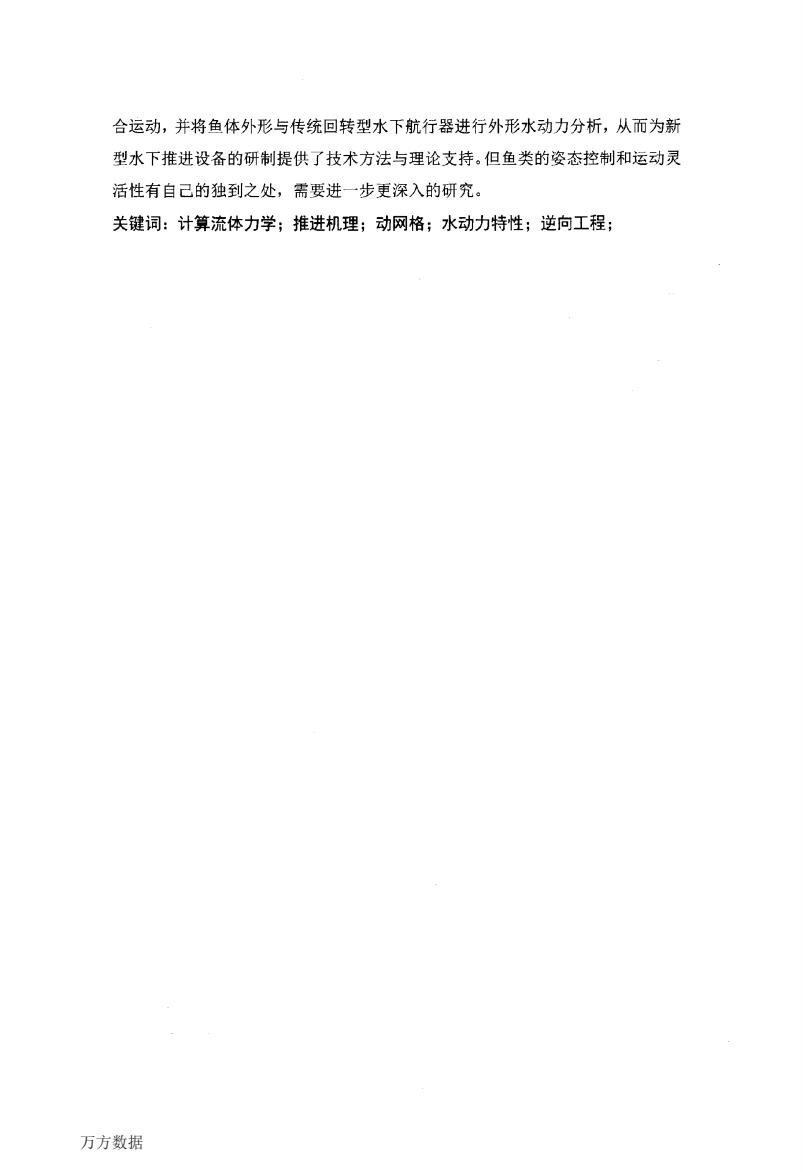
合运动,并将鱼体外形与传统回转型水下航行器进行外形水动力分析,从而为新 型水下推进设备的研制提供了技术方法与理论支持。但鱼类的姿态控制和运动灵 活性有自己的独到之处,需要进一步更深入的研究。 关键词:计算流体力学;推进机理;动网格;水动力特性;逆向工程; 万方数据
合运动,并将鱼体外形与传统回转型水下航行器进行外形水动力分析,从而为新 型水下推进设备的研制提供了技术方法与理论支持。但鱼类的姿态控制和运动灵 活性有自己的独到之处,需要进一步更深入的研究。 关键词:计算流体力学;推进机理;动网格;水动力特性;逆向工程; 万方数据
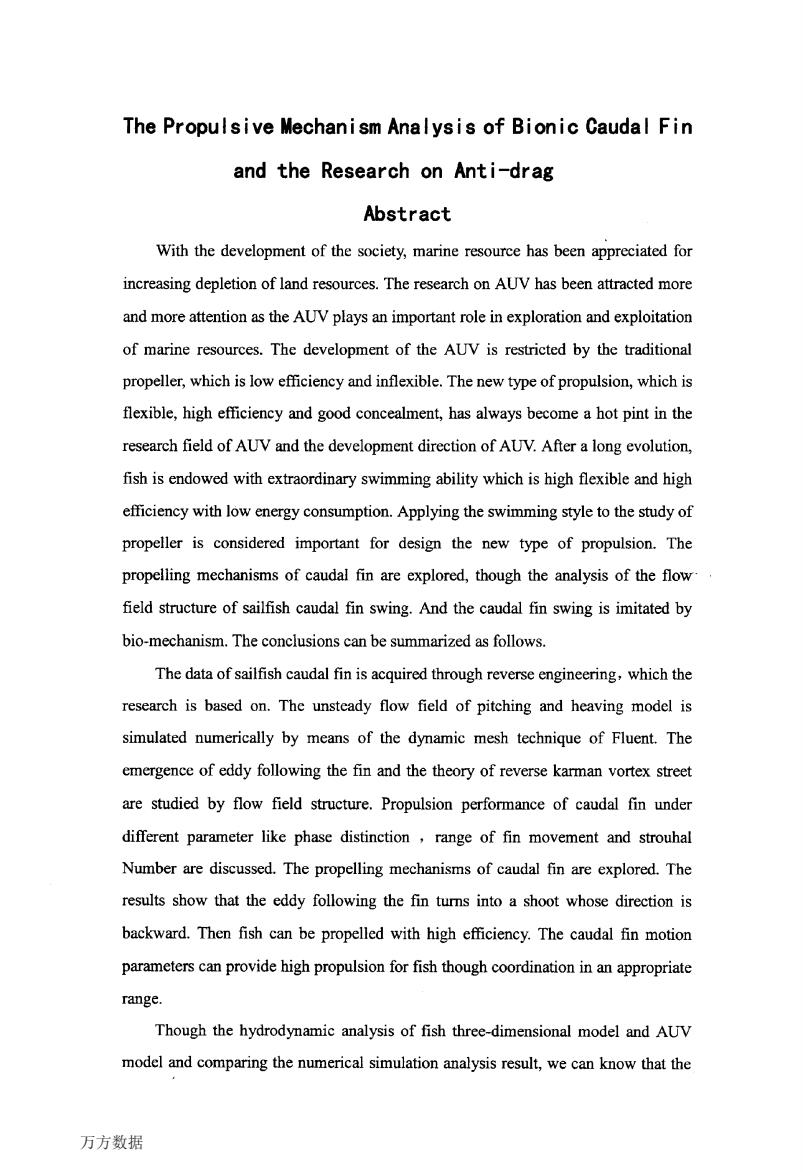
The Propulsive Mechanism Analysis of Bionic Caudal Fin and the Research on Anti-drag Abstract With the development of the society,marine resource has been appreciated for increasing depletion of land resources.The research on AUV has been attracted more and more attention as the AUV plays an important role in exploration and exploitation of marine resources.The development of the AUV is restricted by the traditional propeller,which is low efficiency and inflexible.The new type of propulsion,which is flexible,high efficiency and good concealment,has always become a hot pint in the research field of AUV and the development direction of AUV.After a long evolution, fish is endowed with extraordinary swimming ability which is high flexible and high efficiency with low energy consumption.Applying the swimming style to the study of propeller is considered important for design the new type of propulsion.The propelling mechanisms of caudal fin are explored,though the analysis of the flow field structure of sailfish caudal fin swing.And the caudal fin swing is imitated by bio-mechanism.The conclusions can be summarized as follows. The data of sailfish caudal fin is acquired through reverse engineering,which the research is based on.The unsteady flow field of pitching and heaving model is simulated numerically by means of the dynamic mesh technique of Fluent.The emergence of eddy following the fin and the theory of reverse karman vortex street are studied by flow field structure.Propulsion performance of caudal fin under different parameter like phase distinction range of fin movement and strouhal Number are discussed.The propelling mechanisms of caudal fin are explored.The results show that the eddy following the fin turns into a shoot whose direction is backward.Then fish can be propelled with high efficiency.The caudal fin motion parameters can provide high propulsion for fish though coordination in an appropriate range. Though the hydrodynamic analysis of fish three-dimensional model and AUV model and comparing the numerical simulation analysis result,we can know that the 万方数据
The Propu I S i ve Mechan i Sltl Ana I ys i S of B i on i C Cauda I F i n and the Research on Ant i。。drag Abstract With the development of the society,marine resource has been appreciated for increasing depletion of land resources.The research on AUV has been attracted more and more attention as the AUVplays ail important role in exploration and exploitation of marine resources.The development of the AUV is restricted by the traditional propeller,which is low efficiency and inflexible.The newtype of propulsion,which is flexible,high efficiency and good concealment,has always become a hot pint in the research field of AUV and the development direction of AUV.After a long evolution, fish is endowed with extraordinary swimming ability which is hi曲flexible and l'fi曲 efficiency with low energy consumption.Applying the swimming style to the study of propeller is considered important for design the new type of propulsion.The propelling mechanisms of caudal fm are explored,though the analysis of the flow field structure of sailfish caudal fin swing.And the caudal fin swing is imitated by bio.mechanism.The conclusions Can be summarized as follows. The data of sailfish caudal fin is acquired through reverse engineering,which the research is based on.The unsteady flow field of pitching and heaving model is simulated numerically by means of the dynamic mesh technique of Fluent.The emergence of eddy following the fin and the theory of reverse karman vortex street are studied by flow field structure.Propulsion performance of caudal fin under different parameter like phase distinction,range of fm movement and strouhal Number are discussed.The propelling mechanisms of caudal fin arc explored.The results show that the eddy following the fin turns into a shoot whose direction is backward.Then fish call be propelled with hi【gh efficiency.The caudal fin motion parameters Can provide high propulsion for fish though coordination in an appropriate range. Though the hydrodynamic analysis of fish three—dimensional model and则 model and comparing the numerical simulation analysis result,we can know that the 万方数据
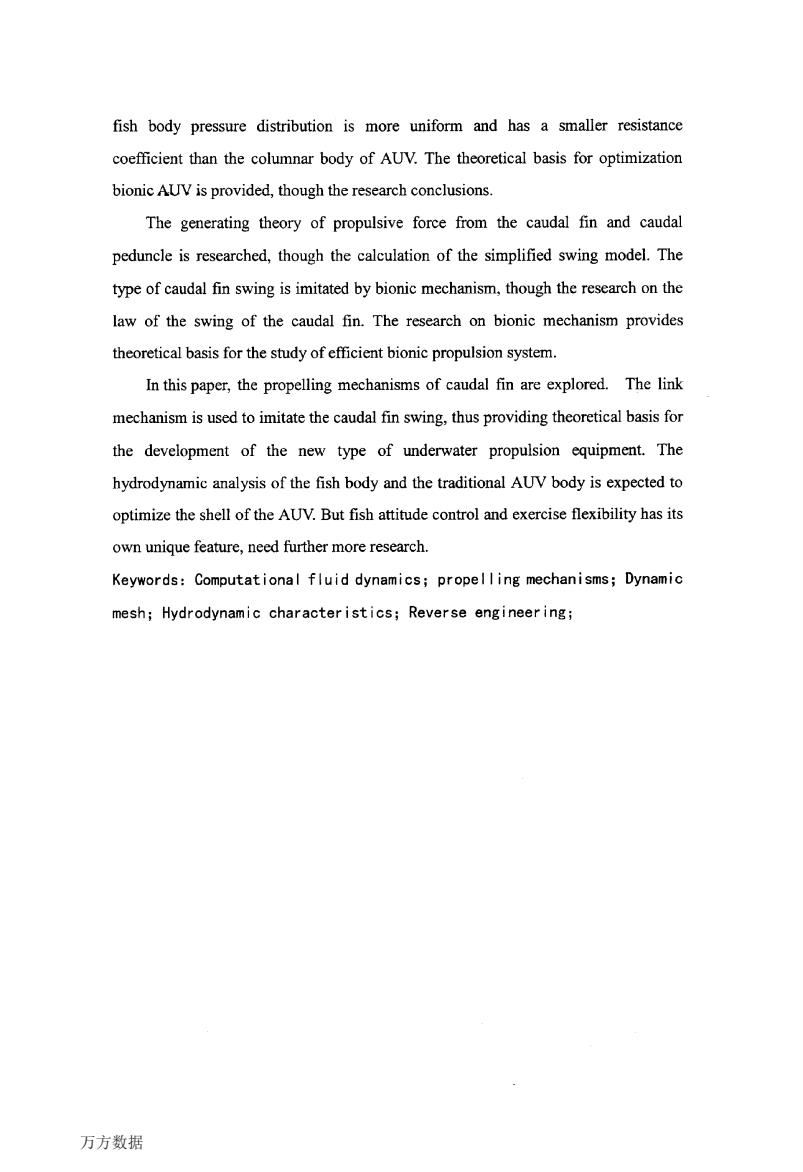
fish body pressure distribution is more uniform and has a smaller resistance coefficient than the columnar body of AUV.The theoretical basis for optimization bionic AUV is provided,though the research conclusions. The generating theory of propulsive force from the caudal fin and caudal peduncle is researched,though the calculation of the simplified swing model.The type of caudal fin swing is imitated by bionic mechanism,though the research on the law of the swing of the caudal fin.The research on bionic mechanism provides theoretical basis for the study of efficient bionic propulsion system. In this paper,the propelling mechanisms of caudal fin are explored.The link mechanism is used to imitate the caudal fin swing,thus providing theoretical basis for the development of the new type of underwater propulsion equipment.The hydrodynamic analysis of the fish body and the traditional AUV body is expected to optimize the shell of the AUV.But fish attitude control and exercise flexibility has its own unique feature,need further more research. Keywords:Computational fluid dynamics;propelling mechanisms;Dynamic mesh;Hydrodynamic characteristics;Reverse engineering; 万方数据
fish body pressure distribution is more uniform and has a smaller resistance coefficient than the columnar body of AUV.The theoretical basis for optimization bionic AUV is provided,though the research conclusions The generating theory of propulsive force from the caudal fin and caudal peduncle is researched,though the calculation of the simplified swing model.The type of caudal fin swing is imitated by bionic mechanism,though the research on the law of the swing of the caudal fin.The research on bionic mechanism provides theoretical basis for the study of efficient bionic propulsion system In this paper,the propelling mechanisms of caudal fin are explored.The link mechanism is used to imitate the caudal fin swing.thus providing theoretical basis for the development of the new type of underwater propulsion equipment.The hydrodynamic analysis of the fish body and the traditional AUVbody is expected to optimize the shell of the AUV.But fish attitude control and exercise flexibility has its own unique feature,need further more research Keywords:ComputationaI fI ui d dynamiCS;propeI ng mechani sms;DynamiC mesh;Hydrodynam C character i st CS;Reverse eng neer ng 万方数据
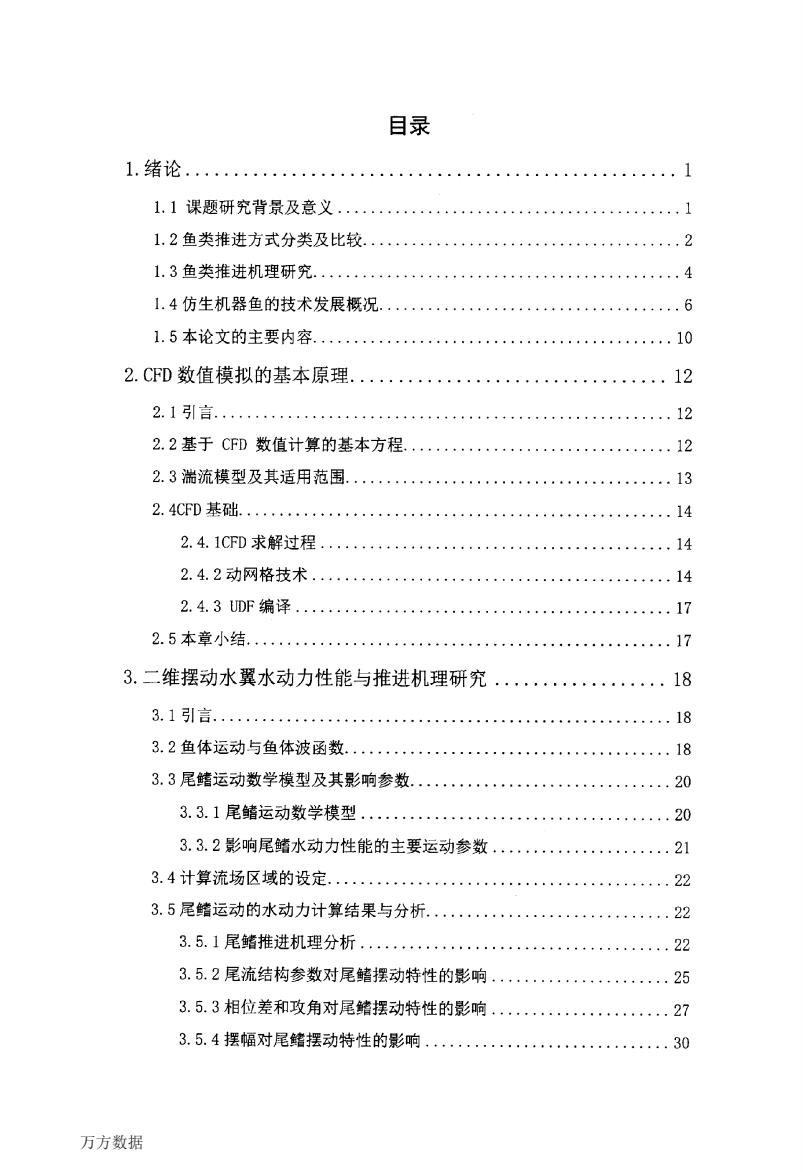
目录 1.绪论.. 1.1课题研究背景及意义..· 1.2鱼类推进方式分类及比较...2 1.3鱼类推进机理研究...· 4 1.4仿生机器鱼的技术发展概况. 6 1.5本论文的主要内容.... ………10 2.CFD数值模拟的基本原理.... 12 2.1引言. 12 2.2基于CFD数值计算的基本方程 .12 2.3湍流模型及其适用范围.. 13 2.4CFD基础....· 2.4.1CFD求解过程...,· ....14 2.4.2动网格技术..· .14 2.4.3UDF编译. ..17 2.5本章小结. .17 3.二维摆动水翼水动力性能与推进机理研究.· 18 3.1引言.. 18 3.2鱼体运动与鱼体波函数...... 18 3.3尾鳍运动数学模型及其影响参数.… 20 3.3.1尾鳍运动数学模型.· 20 3.3.2影响尾鳍水动力性能的主要运动参数,....… 21 3.4计算流场区域的设定.……… 22 3.5尾鳍运动的水动力计算结果与分析.,..... 22 3.5.1尾鳍推进机理分析.……… 22 3.5.2尾流结构参数对尾鳍摆动特性的影响.… 25 3.5.3相位差和攻角对尾鳍摆动特性的影响… 27 3.5.4摆幅对尾鳍摆动特性的影响..30 万方数据
目录 1.绪论......…….…...…...…..…........……....1 1.1课题研究背景及意义.…………….…………….………l 1.2鱼类推进方式分类及比较…………….………………..…2 1.3鱼类推进机理研究………………….…………………..4 1.4仿生机器鱼的技术发展概况.………….…………………..6 1.5本论文的主要内容........…..........….…….............10 2.CFD数值模拟的基本原理..……...…...…….………12 2.1引言.....…..............................….....….......12 2.2基于CFD数值计算的基本方程…………………….……..12 2.3湍流模型及其适用范围………………………………….13 2.4CFD基础....……....….…...…..….…..…….……..14 2.4.1CFD求解过程.……...…...........….…….……..14 2.4.2动网格技术…..….……….…………………….14 2.4.3 UDF编译……………….…..………………….17 2.5本章小结….……….………………………………..17 3.二维摆动水翼水动力性能与推进机理研究………………18 3.1引言…..…………….………….………………....18 3.2鱼体运动与鱼体波函数………………………………….18 3.3尾鳍运动数学模型及其影响参数…………………………..20 3.3.1尾鳍运动数学模型…………….………………….20 3.3.2影响尾鳍水动力性能的主要运动参数………………….21 3.4计算流场区域的设定…….……….…………………….22 3.5尾鳍运动的水动力计算结果与分析………………….……..22 3.5.1尾鳍推进机理分析………………………………..22 3.5.2尾流结构参数对尾鳍摆动特性的影响………………….25 3.5.3相位差和攻角对尾鳍摆动特性的影响………………….27 3.5.4摆幅对尾鳍摆动特性的影响………………….……..30 万方数据

36双尾鳍在流体中推进性能的研究...32 3.6.1数值计算模型建立. 32 3.6.2动网格设置,· 33 3.6.3双尾鳍运动尾祸叠加模式...·......·. .34 3.6.4双尾鳍运动尾涡耗散模式...35 3.7本章小结,· 36 4.仿生体减阻水动力分析.. 38 4.1物体阻力产生机理.., 38 4.1.1航行器阻力基本概念..,… 38 41.2绕流阻力.… 39 4.2逆向工程获取旗鱼三维数据模型 40 4.2.1逆向工程介绍.... 40 4.2.2模型数据提取... 40 4.3简化模型.··…………· 44 4.4鱼体计算域及边界条件设置…… 44 4.4.1鱼体计算域的创建...44 4.42计算域的网格划分.44 4.4.3鱼体计算域的边界条件… .45 4.4.4回转型小型水下航行器的计算域及边界条件设置....45 4.5本章小结…… 5.尾部运动控制方法..·· 48 5.1尾部运动分析... ...48 5.1.2尾部运动数学分析……………… 49 5.1.3尾部运动模型建立· 50 5.2尾部运动动力学模型的建立. 51 5.2.1推进力分析..51 5.2.2鱼体所受阻力分析,. 52 5.2.3推进力的计算..,. 53 5.3鱼体尾部摆动的仿生机构设计.., …55 万方数据
3.6双尾鳍在流体中推进性能的研究…..……………….….….32 3.6.1数值计算模型建立………………………………..32 3.6.2动网格设置………………………..……………33 3.6.3双尾鳍运动尾涡叠加模式.………….………………34 3.6.4双尾鳍运动尾涡耗散模式………….……….………35 3.7本章小结….......…...............…..…..…...…....36 4.仿生体减阻水动力分析….....….......一.…....…...38 4.1物体阻力产生机理……………….…………………….38 4.1.1航行器阻力基本概念……………………….……..38 4.1.2绕流阻力………………………….……………39 4.2逆向工程获取旗鱼三维数据模型…………………………..40 4.2.1逆向工程介绍…..……….………………………40 4.2.2模型数据提取…….…….……………….……...40 4.3简化模型…….……..…….……….….…………….44 4.4鱼体计算域及边界条件设置………………………………44 4.4.1鱼体计算域的创建………………………..……...44 4.4.2计算域的网格划分………………………………..44 4.4.3鱼体计算域的边界条件…………………………….45 4.4.4回转型小型水下航行器的计算域及边界条件设置…………45 4.5本章小结.…......……………………………………47 5.尾部运动控制方法............….…......….....…..48 5.1尾部运动分析….…….…………….………..……….48 5.1.2尾部运动数学分析……….…….…………………49 5.1.3尾部运动模型建立……….…………………..…..50 5.2尾部运动动力学模型的建立…………………………...…51 5.2.1推进力分析….………………………………….51 5.2.2鱼体所受阻力分析………………………………..52 5.2.3推进力的计算…………………………..……….53 5.3鱼体尾部摆动的仿生机构设计…………...…….…………55 万方数据
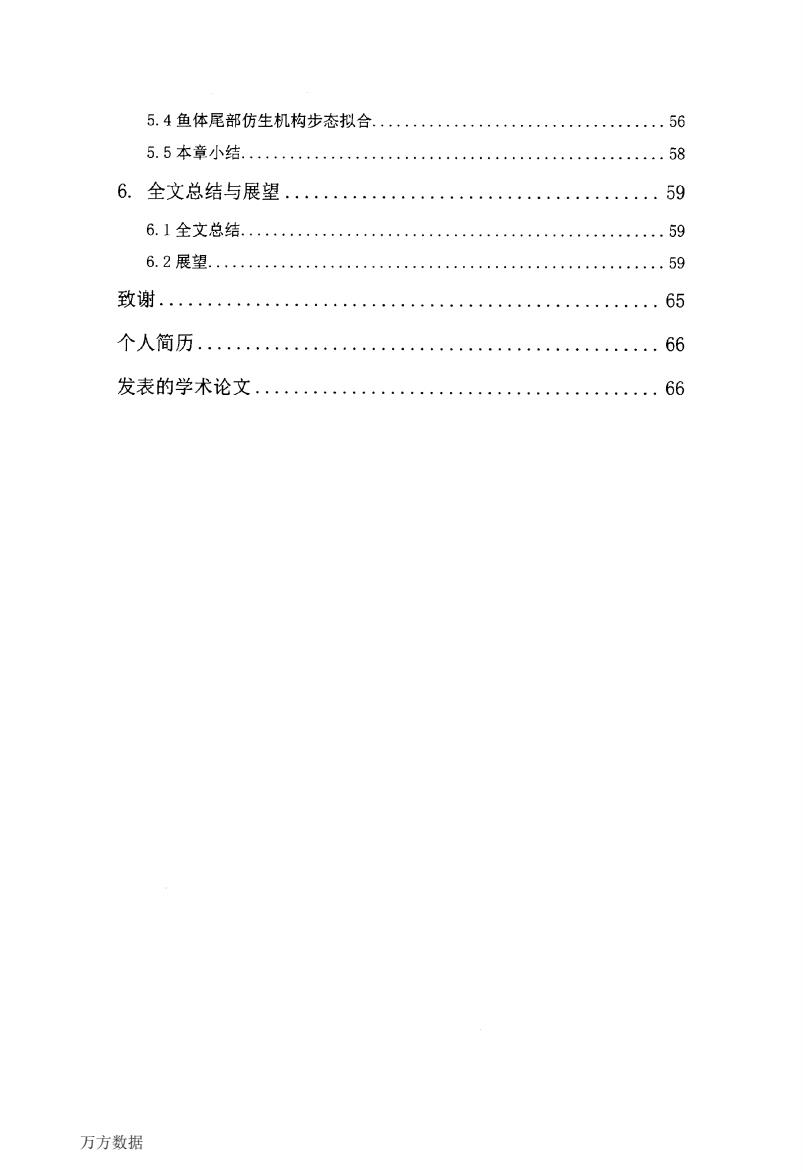
5.4鱼体尾部仿生机构步态拟合………… 56 5.5本章小结. 58 6.全文总结与展望 59 6.1全文总结. 59 6.2展望..… 59 致谢. 65 个人简历.… 66 发表的学术论文.. 66 万方数据
5.4鱼体尾部仿生机构步态拟合………………………………56 5.5本章小结………………….……….………………..58 6.全文总结与展望.…...….........…..…..……....59 6.1全文总结..…..........….….…….….....….……….59 6.2展望..….….....….....….........……..........……59 致谢….….…..…………...…....…….....……65 个人简历..……..…..….….....…...……………66 发表的学术论文.….…..…..…...….......…...…..66 万方数据